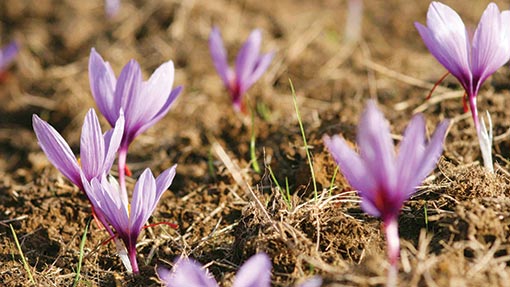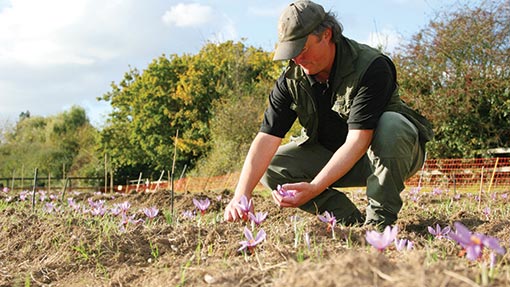Farmer revives lost art of saffron growing

The cultivation of saffron throughout England was once so important a whole town was named in its honour.
But that was more than 500 years ago, when demand for the exotic spice was high and before the Eastern spice trade heralded the industry’s demise.
Fortunately the lost art of growing saffron – the dried stigma of the autumn flowering crocus – has successfully been restored to our shores, thanks to Essex farmer David Smale, who sells his organic product commercially under the banner of English Saffron.
Formerly a geophysicist, David has spent more than a decade perfecting the cultivation, and now supplies top restaurants and chefs – including Hugh Fearnley Whittingstall’s River Cottage – as well as renowned London stores Fortnum & Mason and Partridges.
“It all started because I wanted to grow something, on a small, commercial scale,” explains David. “I looked into a few different things, and then one day I was reading a history of the local area, and it occurred to me about the history of Saffron Walden. I went to the local museum and found that no-one grew it anymore, which was really surprising.”
Saffron is spice gold – undoubtedly the world’s most expensive. This is mainly due to the labour-intensive way it is farmed and the fact it takes some 150 flowers to produce just one gram – 0.2g of English Saffron sells from the farm for around £8.
Commercial scale
“I started to grow some on my patio. I had some problems after first the season, but kept going and I really began commercially in 2004. It’s taken a long while to build up a good stock level to be able to sell it commercially,” David adds.
“There are one or two others growing it now, but not on such a commercial scale. We are trialling in other areas and always looking to expand.
We have to pick them all and dissect them all by hand, as you just cannot do it with a machine
David Smale
“I’d also like to explore the possibility of setting up a co-operative, so other farmers can grow it under the same brand.”
David currently grows his crop on two single acre plots – one near Saffron Walden, in Essex, and another in the Devon village of Exton, on a farm where his family used to grow carnations.
In comparison to the mass-grown saffron produced in Iran, Greece, Kashmir, Morocco and Spain, David says his crop is honey-sweet and not as bitter tasting as other varieties. And it’s a taste which is proving popular, with the company supplying chefs and top department stores across the country.
Saffron has been farmed for more than 3,500 years and used as a dye, fragrance and for medicinal purposes, as well as in cooking.

Its origins lie in south-west Asia, although it was first cultivated in Greece. The first English saffron was grown during the 14th century, mainly in Essex, parts of Suffolk and south Cambridgeshire. In time, Saffron Walden (previously known as Chipping Walden) became the English capital of its production.
The crocus bulbs – or corms, to give them their proper name – are planted in autumn. They remain dormant until March/April, when they die back to a brown grass, then at the beginning of September/August small shoots come through and the plants rapidly develop rich purple flowers, which hold the yellow stamen and the triumvirate of red stigma. And it is these three delicate strands which have to be hand picked, as saffron must be harvested as soon as it’s ready – there is just a tiny window of two or three days.
“It’s very labour intensive; we have to pick them all and dissect them all by hand, as you just cannot do it with a machine. They then have to be processed properly,” David says.
“I liken it to tobacco; they have to be dried properly. If you over-dry them they will go brittle and you’ll end up with a bag of dust within six months. Under-process them and they will go all mouldy in the storage container. Saffron has got a good shelf life as long as it’s stored right.”
After harvesting, David’s crop is dried on racks for a day, before going into storage containers.
“It’s a very temperamental crop to grow. Last summer was not good at all – saffron likes reasonably cold weather and then during the summer it likes it nice and warm and dry, but not too wet.
“You can’t wash it. Even though it goes through a lot of processes, we have to wear latex gloves to handle it, and you can’t use chemicals on it, as this will affect the flavour.”
The yield varies, but on average you would expect to get 200-300g from about half an acre.
“Abroad it’s sold in 1-5g pots, while in England, it’s traditionally sold in 0.5g.
English Saffron is very much a family business, with David’s sister Penny Attwood taking care of the promotional and business side, while the artistry, logo design and the violet hand-painted storage jars are the work of his artist/fashion designer niece Louise.
When it comes to eating saffron, most people associate it with rice cooked in Indian restaurants, although David says this really doesn’t capture its delicate flavour, as it is often used in conjunction with turmeric and a lesser amount is used, just to get the colour. And if too much is used it can leave a bitter taste.
“Saffron is routinely used in cakes and buns in Cornwall, but it can be used in a host of other dishes, too. There are some lovely saffron soup recipes, and it can be used in savoury and sweet dishes; saffron ice-cream is nice, too. But it’s best to keep it simple, such as stir-fried chicken with saffron-infused cream and spinach to make a Florentine.
Sipping gin
“And people use it wrongly too; you should put it in a small amount of liquid to start with in a ramekin and leave it for two hours – preferably overnight and add half during cooking and the remainder at the end, as this allows it to infuse. “Get it right, and it’s perfect.”
David has also added a rather more unusual product to his range this summer – saffron-infused gin. Made in conjunction with an artisan producer, the English Saffron Gin is a sipping gin and will shortly be available through the company’s website, while staff at a London hotel are using it to create a new variety of cocktails.
The rare distilled gin begins life as vodka made from East Anglian sugar beet, explains David, before it is redistilled in 200-litre copper pot stills with juniper berries, coriander, crushed macadamia nuts and fresh citrus zests and finally infused with English Saffron.
The spirit is said to taste best served simply with crushed ice, as Martini with a torn bay leaf or with tonic and a slice.
Looks like David and his team are certainly getting things right, having firmly re-established the cultivation of English Saffron to its rightful place at Saffron Walden.
